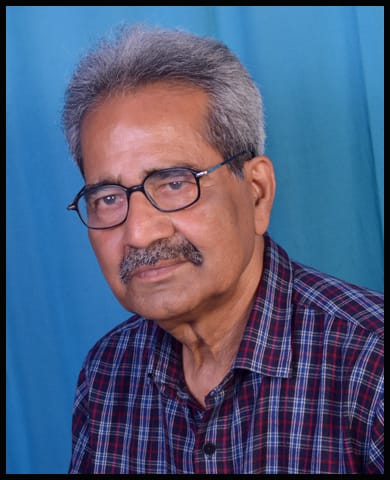Interview - Mustajab Shelle

Mustajab Shelle has been creating portraits, paintings, sketches, and drawings for over five decades. If you’ve travelled by train through North India, there’s little chance that you would not have noticed his work. The most prolific cover artist in the Hindi pulp fiction industry collaborated with best-selling authors like Surender Mohan Pathak, Ved Prakash Sharma, and Colonel Ranjit. When not painting, he writes short stories and poems.
Shelle is a resident of Shafatpota in Amroha.
1. You started as an art teacher in 1966 but took up book cover designing in 1971. How did this happen?
The salary was very low at that time. I earned only two hundred forty-six rupees in Chandpur and couldn’t cover my parents’ expenses in Amroha. It made me feel ashamed of myself. When I started designing the covers of books, I told my parents that now they didn’t have to do anything.
The principal at that time even asked me, ‘Your high school and intermediate exam results are 100%, so why have you decided this?’ I replied that I prayed to God that I wouldn’t have to work a job. He got upset with the reply.
2. What or who inspired you to take up art? What medium do you like to work with as a painter?
In grade eight, a set of charcoal paintings was put up in the school, and I was completely taken aback. The year was probably 1962. I asked my class teacher, Mr Bhargava, about the artist behind them. He told me it was Bhai Lallan (nickname of Eqbal Mehdi). Since I was a very good student, he also promised to let me meet the painter on his next school visit. When I met Bhai Lallan, he got ready to teach me after seeing my enthusiasm. I learned charcoal sketching from him until he left for Pakistan in 1964.
That same year, the company managing four theatres in Lucknow (Basant, Naaz, Mayfair, and Ashok) hired me as a designer. I created posters for the Basant Cinema. It was a brief stint.
I began painting realistic artworks, primarily portraits, at the age of 14. In 1962, I started with charcoal and watercolor, followed by pen and ink and oil painting in 1967. About 20 years ago, I explored acrylics. Additionally, I experimented with abstract paintings, incorporating semi-realistic figures in geometric styles.
3. You designed many covers and worked for various publication houses. How was the journey?
Yes. I designed extensively until the 2000s, with around 7000 covers of books, novels, magazines, and even advertisements. I once kept a three-year list in advance. However, book sales went down after 2005.
4. Any publisher or writer that you shared a special bond with.
I mainly shared cordial relations with everyone I worked with. Ved Prakash Sharma, in particular, was close to me. I first met him in 1975 at a publisher’s office in Meerut. The publisher introduced me to a 16-17-year-old young man. I told the author that I’d design anything that he desired. We stuck an instant bond during that moment. Sadly, he passed away relatively early in 2017.
5. AI is now creating visuals based on what the user wants. As it becomes more intelligent, it can even imitate renowned artists. Do you worry?
I have no trouble with it. An imitation is just an imitation. Only those blessed by God with a good voice can truly sing!
6. You started writing stories and poetry relatively late. Didn’t you feel the urge to write earlier?
I have always been passionate about stories and poetry. However, I never had the time to pursue them. In 2010, when I entered the field of painting, I finally found the time. I’m working on my first collection of short stories and poems in Urdu, many of which have been published in magazines.
7. As an artist, you’ve mostly lived a quiet life in Amroha. Did settling in a city like Mumbai or Delhi cross your mind?
I moved to Delhi twice. From 1976 to 1978, I lived in Model Town. When my health worsened, I returned. The second time, from 1981 to 1983, I lived near Turkman Gate. In 1983, when my father passed away, I returned again and never moved elsewhere.
8. How did Mustajab Ahmad Siddiqui become Mustajab Shelle?
Shelle is borrowed from Hindi and Sanskrit. In Hindi, ‘sheli’ means style; in Sanskrit, ‘shail’ refers to a mountain. When I designed covers for Hindi books in 1971, I adopted this pen name and still use it.
Mustajab Shelle in conversation with Inam Abidi Amrohvi. (February 14th, 2025)

